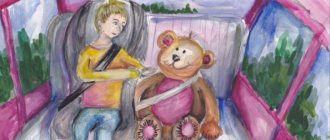The behavior of children in transport is very often discussed. Some children climb up onto the seat with their feet, interfere with other passengers, stain their clothes, and scream. This naturally annoys other passengers. Of course, you need to be a little more tolerant of children, but this does not mean that children should not follow the rules of etiquette.
Not only adults, but also children should know and observe how to behave in transport. This needs to be explained to the child, told. Before the age of 7, everything that parents do is the only right thing. It is mom and dad who create negative or positive habits and form rules. Let's try to figure out how a well-mannered person should behave.
Safe behavior of children in public transport
Note to parents: if you don’t explain something to your child, he simply won’t know it. Many obvious postulates that are relevant for adults are not so unshakable for children. The solution is simple - before sending a child somewhere unaccompanied by parents, you need to talk to him about what safety rules exist in transport for children.
Among them are the following:
- Don't get too close to the road. Standing on the curb is also not recommended, especially in icy conditions.
- It is necessary to evaluate the trajectory of the vehicle, monitor its direction while reducing speed and approaching a stop.
- People enter public transport holding the handrail.
- If the child is under 7 years old, a parent must hold his hand. The baby holds on to the handrail with his other hand.
- You can't stop near the doors.
- You need to hold on to one of the available handrails until you can sit down.
- It is prohibited to stick your arms and head out of open vehicle windows.
Please note that a child can be placed on public transport unaccompanied by an adult if he has reached the age of 7 years. It is not recommended to do this before. Prepare your child in advance for such an important process.
Travel after the age of seven is paid in full. Depending on the pricing features in the region, the price may vary. Also, in some localities and on a number of routes, there are separate rules that provide for the possibility of a child traveling at a partial price (with a discount), for example, during school hours.
From about 3-4 years old, parents should explain to children how they get to certain places. Children are taught safety rules from the same age. The child must clearly understand that he is going somewhere with his mother, father or another adult. The purpose of this is to get to a point in a city, region, or country as a whole located at a great distance from the current location.
On short routes you need to pay special attention. Tell your child why the minibus, bus or trolleybus stops. List the names of the streets, explain why we are now driving along Pushkin Street, and in a couple of minutes it will already be Svobody Avenue. Learn to distinguish between “left” and “right” and understand the essence of turns. By the age of 6, children should clearly imagine in their imagination the most frequent routes, guided by the names of stops and identification signs, places that they remember.
Photo source: https://www.shutterstock.com/
Where to go regarding rights violations
There are unforeseen cases when the driver does not react in any way to a report of an injury and continues driving. According to the law, this unprofessional behavior can be equated to the situation of leaving the scene of an accident (Part 2 of Article 12.27 of the Code of Administrative Offenses of the Russian Federation): “Code of the Russian Federation on Administrative Offenses” dated December 30, 2001 N 195-FZ (as amended on August 2, 2019) . and additional., entered into force on September 1, 2019) This is subject to arrest for up to 15 days or deprivation of rights for a period of 1–1.5 years.
Of course, in this case it will not be possible to call the police to the scene of the incident. Therefore, parents need to find information about the insurance company in the transport (write it down or take a photograph), the driver’s last name, vehicle number, telephone numbers and names of witnesses. Again, you should save the ticket and go to a medical facility so that the child’s injuries can be recorded.
Next, the parents submit an application to the insurance company with the available documents for compensation not only for health damage, but also for moral compensation.
Child on the subway
The metro is free for children under 7 years of age. In this case, a separate seat is not provided - the baby is in the arms of an adult who accompanies him.
Safety of children in public transport on escalators:
- hold on to the handrail;
- be on the right side;
- stand facing the direction of movement;
- do not touch immovable parts.
It is recommended to carry children under 7 years of age when using the escalator.
The following rules apply on the platform:
- it is forbidden to go beyond the boundary line (you need to show the child what it looks like);
- it is necessary to free up space so that passengers can get out;
- It is allowed to enter the carriage after passengers wishing to leave the carriage have done so (when explaining this to the child, emphasis should be placed on this).
If the child is under 7 years old, he or she must be held by the hand on the platform.
Child safety rules for parents in subway cars:
- you cannot lean against the door of the carriage;
- you need to hold on to the handrail;
- prepare for departure in advance;
- After the announcement of the door closing, disembarkation and embarkation should be stopped.
Explain to children where handrails are convenient for them. You should also display a passenger-to-driver device that can be activated to provide communication in the event of an emergency.
Basic preventive rules
- While waiting for the bus, stand in a well-lit area near other people.
- Avoid deserted stops at night.
- If you are driving late, sit next to the driver, closer to the aisle, so that it is inconvenient for someone to sit next to you. If, despite this, a suspicious stranger tries to sit next to you, let him go to the window or change seats.
- Do not lean against doors and, if possible, avoid riding on steps and in aisles.
- Don't leave your things unattended.
- If a bully enters the salon, do not meet his eyes.
- When traveling by train, sit in the carriage with the most passengers, closest to the police call station.
- Don't stand in the vestibule.
- Try not to stay in a carriage with a drunk company.
Pedestrians and passengers in cases of emergency need to remember a number of rules:
— boarding and disembarking is carried out only after the transport has completely stopped;
- do not strive to be in the front row, especially when waiting at bus stops;
— in transport, take seats away from exits and aisles;
— ensure yourself a stable position in the cabin; when you stand, hold on to the handrail. The best point of support is the handrail above your head;
- stand facing the direction of travel, so you can always see the danger in advance and, what is also important, in the event of an unexpected collision or braking you will not fall on your back (this is especially dangerous);
- do not place luggage on the floor in the aisle - it will interfere with other passengers;
— do not move around the cabin while driving. If necessary, find intermediate support points;
— the only condition that optimally guarantees safety during braking or a collision is a stable, fixed position;
- if you still fall as a result of a push or braking - group yourself, cover your head with your hands;
- think about the possibility of providing yourself with an emergency exit - study the procedure for using an emergency exit, using the bus hatch or carriage windows;
— when using modern transport, it is necessary to remember that in case of accidents the area of transport power plants is especially dangerous; engines of fuel tanks, conductive elements; in case of an accident, stay away from these areas;
— motor vehicles are a fire hazard, so even in the event of a minor accident, it is necessary, after getting out of the bus or car, to move 10-15 m away from them as quickly as possible, in order to avoid death from a possible explosion or fire. Electric vehicles are dangerous due to the possibility of electric shock; when exiting, you must jump out of them without touching the ground and the vehicle at the same time.
Urban transport
- this is the metro, bus, trolleybus, tram, taxi.
Bus
- the most common type of transport.
If an accident occurs and the doors are jammed, get out through the windows, first breaking out the glass with any available objects. When a bus overturns, ventilation hatches can be used as emergency exits. In case of flooding (falling into a river), try to maintain composure at all costs, do not try to leave the cabin immediately, because the oncoming flow of water will not allow you to do this. Once the cabin is filled with water, it will be easier to leave.
Trolleybus, tram -
least dangerous modes of transport. But electric traction creates the possibility of electric shock. In such situations, sitting seats are the safest, and it is recommended to leave the cabin only by jumping to prevent electric shock.
If a fire occurs in the interior of a tram (trolleybus), extinguish it only with carbon dioxide, powder fire extinguisher or sand.
The passenger must comply with the following rules:
1. If any emergency occurs, first of all act as directed by the driver.
2. Do not get out of the car when the driver turns the switch.
3. Do not jump into a tram (trolleybus) while it is moving.
4
Exit the tram (trolleybus) carefully so as not to get hit by moving vehicles. The tram passage should be bypassed in front, and the trolleybus - behind
5. When passing near the doors, beware of bruising your hands from the doors of the rolling stock.
6. Do not lean out of windows for fear of being hit by moving vehicles or any obstacles.
7. When a tram (trolleybus) approaches a stop, do not approach it less than 0.5 m, so as not to be hit by its protruding parts and accidentally get under the wheels.
8. Do not touch handles and door control mechanisms unless necessary.
9. It is prohibited to approach a tram (trolleybus) that has emergency stop signs posted.
10. It is prohibited to talk to the driver while driving.
11. When moving, you need to hold onto the handrails securely.
Metro.
An extreme situation can arise in any mechanism.
Child on a bus and trolleybus
Rules for the safety of children on public transport (bus, trolleybus) can be combined into the following simple guide:
- Before boarding, you need to wait until people wishing to leave the vehicle get off. To do this, the passage is cleared.
- There is no need to linger at the door - people are walking behind, and the child must remember this.
- You should not smear the seat or other objects with your feet - your feet should always be tilted downwards.
- They don't eat on transport. This is especially true for cakes, ice cream, pies, etc. Limit your consumption of drinks - during the trip you can be harmful to your health.
- Noise is not the best travel companion. Explain to your child that shouting and talking loudly is prohibited.
- Show how to hold on to the handrails to avoid falling. The support must be maintained until the vehicle stops. Then you can release the handrail to get out. During the exit, it is also recommended to hold on.
As already noted, up to the age of 7, in transport, the parent holds the child in his arms. There are several such places on trolleybuses and buses. The quantity may depend on the capacity of the transport. As a rule, the first two are intended for disabled people, passengers with children, elderly people and pregnant women. They are located behind the driver.
Don’t forget to teach your child to treat other people politely and to give way to representatives of the categories of citizens listed above.
Where should seat belts be? All buses that transport passengers intercity are equipped with seat belts.
Should a child seat be provided for infants? Similar to the rule described above, an accompanying rule has been introduced. In accordance with it, buses that provide intercity transportation services (a route of more than 50 km are considered as such) must have separate seats for transporting passengers aged 0 to 12 years. Child restraints look like special seats equipped with seat belts.
Photo source: https://www.shutterstock.com/
Fines for passengers in 2022
The Code of Administrative Offenses provides for 2 options for fines for passengers:
- Article 12.29, part 1 – warning or 500 rubles. Imposed for any violation of the rules that did not interfere with other road users. For example, such a fine threatens a passenger who does not wear a seat belt.
- Article 12.30 part 1 – 1,000 rubles. Imposed if the passenger interferes with the movement of vehicles. For example, he was not convinced that there were no cars and opened the car door from the side of the roadway.
This concludes the review of the rules for passengers.
Sources
- https://vospitanie.guru/povedenie/v-transporte
- https://etiketclub.ru/etiket-v-transporte
- https://www.tutu.ru/2read/bus/bus_rules/
- https://vplate.ru/etiket/pravila-povedeniya-v-obshchestvennom-transporte/
- https://fireman.club/statyi-polzovateley/pravila-bezopasnosti-v-obshhestvennom-transporte/
- https://pddmaster.ru/pdd/passazhir-pdd.html
What to do in case of fire or accident
To ensure that the safety of children in transport is maintained even in difficult emergency conditions, they need to be familiarized with a set of basic rules, including the following:
- You need to be in the middle of the cabin - this increases the chance of avoiding damage in the event of an accident.
- Seated places are the safest. If a child notices that there are live objects in the cabin, they should not touch anything with their hands or other parts of the body. You need to go outside as quickly as possible while remaining calm.
- If passengers begin to panic due to an accident or fire, a stampede may occur. The solution to the problem is to use the emergency exit by tearing out the cord and pushing out the glass (sometimes a button is installed instead of the cord).
- If a fire occurs, you must leave the cabin. If this cannot be done, you should evaluate your location. Once the fire extinguisher is nearby, the equipment is removed and used to extinguish the fire.
- If a bus or trolleybus falls into the water, you need to wait until it is half filled with water. Next, the child dives and swims to the exit, crosses it, and swims out.
- In the event of a fire, you need to call 112, and also notify the driver if this has not been done previously.
- In any difficult situation, you can use the button to open the door in an emergency and provide free access to the exit.
Explain to your child that in the event of an accident or fire, you need to remain calm. Panic and slowness are extremely undesirable. Decisions and actions must be consistent and balanced - in this case, you can trust your child to use public transport independently. Safety and transportation of children are regulated by basic rules, and this applies not only to the metro, but also to trolleybuses. Tell your children about the possible consequences of their violations, give practical advice while on the bus with them.
Safety regulations
Rules of safe behavior must be followed in all situations. They were invented in order to preserve the health of a person who uses a bus, tram, train or plane. They apply to both adults and children, especially schoolchildren, who can independently use various transport services without parental accompaniment. Let's look at the main ones.
Memo: Rules for boarding and disembarking
- It is necessary to wait for the vehicle only at a specially equipped stopping point (stop);
- You should approach the entrance doors of a bus or train only after a complete stop; it is forbidden to jump into open doors while moving;
- If you notice that a bus or trolleybus is crowded, it is better to wait for the next one;
- Before entering a bus or other vehicle, you must let all exiting passengers pass;
- You should enter slowly, respecting the order, without trying to get ahead of everyone;
- After boarding, do not stop at the very entrance (unless you have to get off at the nearest stop), calmly walk to the middle, leaving space for those who enter after;
- There is no need to try to get off the bus or trolleybus first - it is best to wait until the main crowd of passengers leaves;
- It is advisable to cross the street after disembarking after the vehicle has left the stop;
- When boarding a tram, you must always go around it from the front, a bus or trolleybus - from the back.
Rules of behavior in nature for preschoolers
Memo: Rules for safe behavior on the road
When traveling, you should always behave with dignity and adhere to some safety rules and etiquette.
Main safety rules:
- You must not make noise, push, or cause other inconvenience to passengers;
- The transportation of flammable, flammable substances and sharp objects is prohibited in any transport. Large items (bags, backpacks) are best placed where they will not interfere with other passengers;
- The driver must not be distracted while he is working;
- It is necessary to hold on to special belts and handrails;
- In transport, it is better to stand facing to the side in the direction of travel or half-turn. You should not stop near the doors, much less lean out of the windows while moving or the doors when starting to move;
- Pets are transported in special cages and carriers; dogs are muzzled.
Memo: Rules of behavior on the bus (trolleybus) during the trip
When traveling on any transport, you must be polite to other passengers and follow the following rules:
- When entering, you need to take off your bags and backpacks so as not to touch other passengers or get them dirty;
- On the bus they don’t shake the snow off their clothes or the raindrops;
- According to generally accepted rules of behavior when boarding any transport, the first to enter are always the elderly, pregnant women, and the disabled. It is to them that schoolchildren must yield. The same must be done when leaving a public vehicle;
- It is advisable to prepare for the exit in advance (especially if there are a lot of passengers). Ask those in front: “Are you getting off at the stop?” Apologizing, ask permission to pass, and not push, silently making a way for yourself with your elbows;
- In the cabin it is necessary to give up seats to the elderly, women with small children, with heavy bags, and the disabled;
- In transport you should not push, try not to step on feet, do not lean your elbows on the person who is nearby, do not push him;
- In the cabin of a bus, trolleybus, tram they do not talk very loudly, do not lean out of the window, do not disturb passengers when exiting or entering;
- It is necessary to pay for the trip and, if necessary, show the coupon or ticket to the controller, the conductor, after the trip, the ticket is thrown into the trash bin;
- If you use a travel document, you need to keep it ready when boarding so as not to waste the conductor’s time and not cause inconvenience to other passengers when searching for it;
- If it’s uncomfortable to hold on in a crowded cabin, and you’re holding flowers or a cake, then don’t be shy and ask passengers to hold them;
- It is not customary to look closely at passengers, lean on them, or look into the phone or book of the person sitting or standing next to them;
- You cannot be rude to other passengers. If a remark is made about something, you should take note of it and try to improve;
- You cannot dirty the seats, climb on them with your feet, paint them, eat ice cream, cakes, comb your hair, clean your nails, laugh loudly, talk, discuss problems publicly, and much more.
Safe behavior of the child at home, in the apartment and in the entrance
Bottom line
It is very important to familiarize children with the rules for traveling on public transport in advance, long before the moment when parents can let the child “travel” around the city on their own.
Adults also do not need to forget about the rules for transporting small children, hold their hands, and monitor their safety. This is especially true for traveling on the subway and crossing intercity routes. Please note that his behavior in transport depends on how careful you are and how succinctly and clearly you can present information to your baby.
How to log in?
Boarding a vehicle, being an extremely simple procedure, still presupposes certain rules of decency. Knowing them will help you avoid a scandal at a bus stop.
- You should not try to board the vehicle as soon as it arrives. It makes more sense to first let out passengers who want to get out. It is worth observing the queue, but even if one has not been formed, you should not push, trying to get inside the vehicle as quickly as possible.
- For a long time, it was considered an unconditional rule of good manners for schoolchildren to help pensioners and pregnant women board the bus. However, today it is recommended to first ask whether this is appropriate. A person may be independent enough to enter the salon without outside help, but someone else's touch or the very fact of being perceived by strangers as helpless can offend.
- Schoolchildren often carry a heavy briefcase or bag with them. If such a part is worn on the shoulders, when landing it is better to remove it and hold it in your hands.










